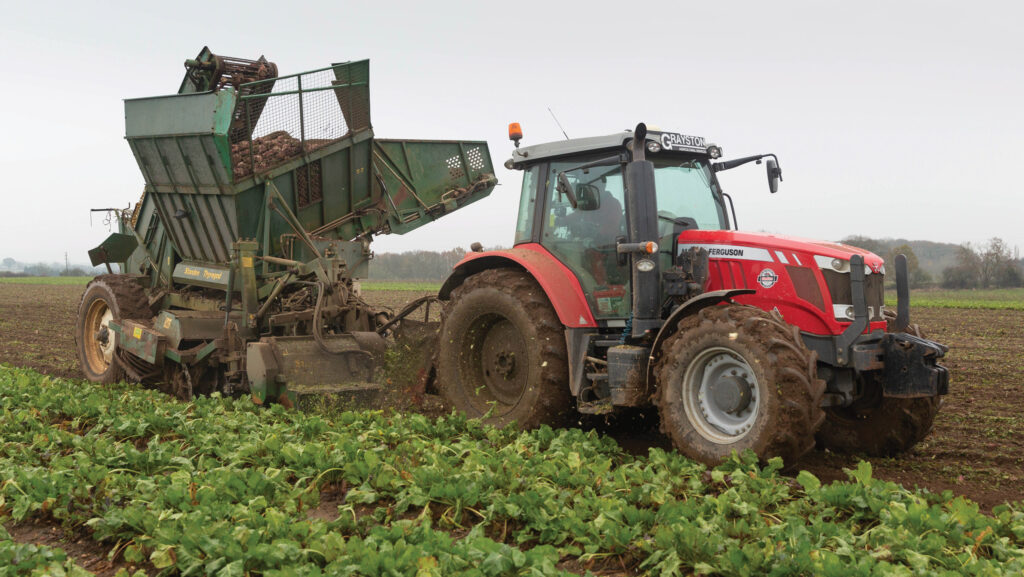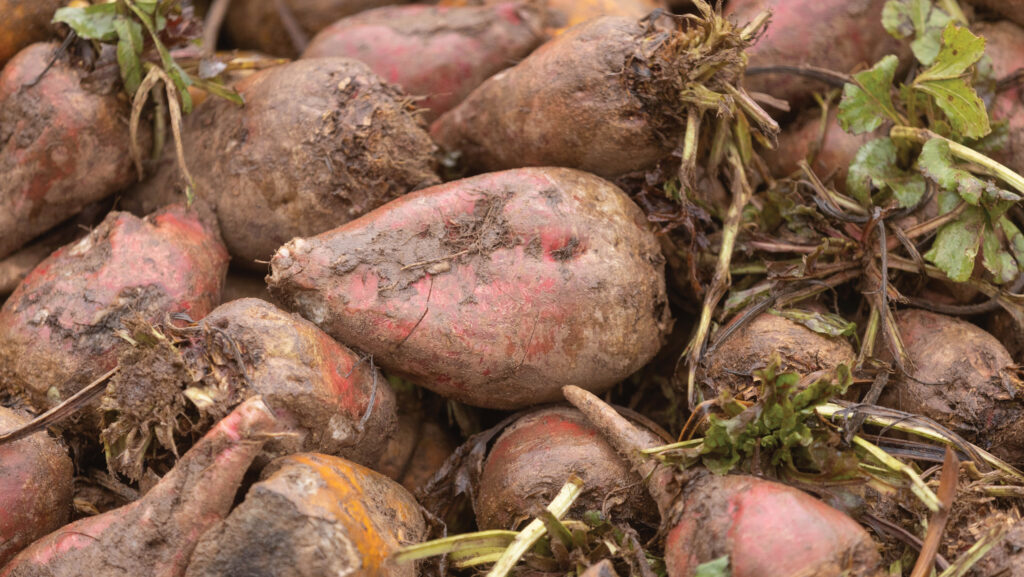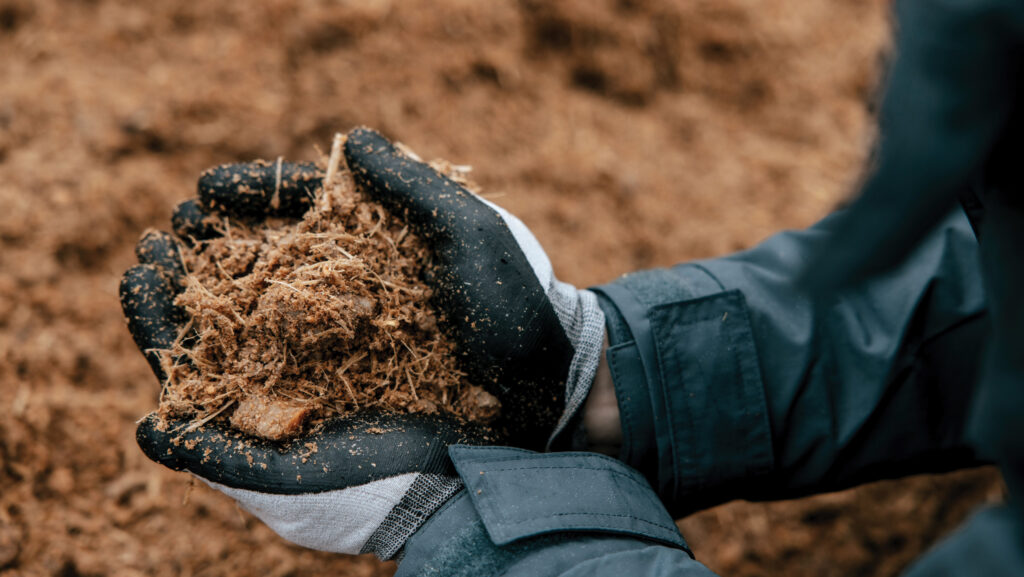Benefits of topping silage clamps with fodder beet
 © Tim Scrivener
© Tim Scrivener Topping clamps of maize or grass silage with a layer of fodder beet can provide a ready-made total mixed ration without the challenges sometimes associated with ensiling this mix.
Clamping crushed or chopped fodder beet with silage is commonplace in northern Europe, but farmers tend to introduce it in layers between the maize or grass, or mix it together as one feed before ensiling.
An alternative method, which has been developed by plant breeder and seed supplier KWS, involves spreading a 1-2m layer of chopped beet on top of the pit.
See also: Video – advice on feeding fodder beet to dairy stock
This method solves some of the problems layering or mixing can present and helps enhance the feed value, says Powys-based grass and forage consultant Marc Jones.
This is because the maize or grass and the beet can each be harvested at their optimum stage, and losses that come with moving forage from one clamp to another can be reduced.
“It makes feeding feed beet more versatile and opens up possibilities for farmers who might not otherwise have considered it,” he suggests, adding that the effluent from the beet, which has a high sugar content, is also absorbed by the silage instead of being lost, adding value to the feed.

Fodder beet © Tim Scrivener
The depth of the beet layer in this so-called “brownie-style” ensiling will dictate how far down the silage the effluent will run.
For example, if the layer is 80cm, it will be absorbed by the first 80cm or so of the silage.
But the greatest advantage is that once clamped, beet can be fed all year round.
“Prior to clamping, the beet would only last around three months in stacks, and frost could be an issue in the winter,” says Marc.
Cost advantage
There can be a cost advantage to clamping beet with forage instead of using other feed sources that have similar feed values.
“Fodder beet can replace concentrates or grain like barley in a ration, yet the cost is much lower – more similar to the cost of producing grass silage,” he calculates.
“There is a bit of work involved in chopping the beet and placing it on the clamp, but it gives you a TMR [total mixed ration] diet ready to go.”
The sugars in the fodder beet and the starch and fibre in maize combine to create a high-energy feed.
Danish farmers were among the first to experiment with co-ensiling beet.
They placed it on top of silage already ensiled (removing the sheet and then resealing the clamp) or adding a layer to freshly harvested maize before covering.
Lars Andersen of KWS says handling and storage of beets after harvesting is one of the most frequent reasons why the crop is not a common feedstuff on dairy farms.
Recognising this issue, he says the business collaborated closely with Danish farmers to develop and implement improved storage solutions.
Timing
“Initially, beet was ensiled with maize at harvest time, but that doesn’t give you the full potential of the beet yield because they have to be lifted early,” he says.
“Nevertheless, farmers had been trying to ensile using what we have termed ‘lasagne’ or ‘one-pit’ style.”
Creating a lasagne effect involves removing the silage from one clamp and emptying it into another, adding the beet in layers between that silage.
“This works for maize or grass; it can be done, but it requires a lot of work,” Lars points out.
Mixing beet with silage before it is transferred to a clamp also needs additional space for ensiling, although it can also be made into highly compressed bales.
However, by placing the beet on top, each crop can be harvested at its optimal time. For fodder beet, this is usually from mid-October onwards.
“The work effort is significantly lower, as the silo does not have to be emptied and refilled again, and we minimise the risk of re-ensiling losses too.”
Ideally, the beet should be ensiled at a dry matter (DM) of about 25%. The beets must be covered and stored for at least two weeks, preferably three, before ensiling.
Marc says this allows them to dry out (along with any soil attached) and mature and reduces the volume of effluent they produce.
“The effluent converts from sugar to alcohol and contains valuable nutrients that run down into the silage instead of seeping away into the effluent tank in the silage pit. All that moisture is retained in the silage,” he says.
Brownie-style ensiling also provides flexibility on when the fodder beet is harvested as there is the option of removing it in stages to reduce the initial workload.
“A third could be harvested initially, another third in December, and the rest in late winter because it will happily sit in the ground until then.
“I wouldn’t recommend this in regions that are prone to heavy frosts, though, because this can damage the fodder beet,” he adds.
Chop size
This flexibility also means the grower can adjust the amount of beet included in the diet at different times of the year.
The beet can be chopped with a specialist cutter (fitted to a loader) that removes any stones and provides a good distribution of different sizes of pieces.
“It is important to have that mix, [with] ‘crumble’ to fill the space between the bigger pieces,” Lars advises.

Silage with fodder beet © KWS
“The crumble makes it possible for the beet to fall down and ensile by itself, removing the need to drive on the clamp to compact it.”
When ensiling beet on top of silage, it is important not to fill the clamp right to the top of the side walls with silage, as room must be left for the beet to be added.
The top of the silage should come no higher than 50cm below the top of the pit walls.
“The rule of thumb is that 1m [depth] of beet releases 1m of effluent into the silage,” he says.
“To avoid possible losses of effluent in the silage, we do not calculate the last 50cm in the amount of beet that can be added. This means that on 2m of silage, you can add no more than 1.5m of beet.”
After three weeks of ensiling, the height of the beet will have reduced by 40-50%, he adds.
Simplicity
A typical analysis should show a pH of 3.9 in the beet, 3.7 in the maize layer containing the absorbed sugar effluent and pH4 in the bulk of the maize silage.
Lars says any risk of bacteria, mould or yeast in the forage is very low.
“The layers of the beet and the maize have a decent amount of acetic and lactic acid in the absence of butyric and propionic acid,” he explains.
He believes the relative simplicity of the system could encourage more farmers to consider ensiling beet with forage.
“This new technique has potential for UK livestock farmers who want to increase home-grown feeds.
“After adding the beet on top, it is just a case of putting the sheet on again and the job is done.”
